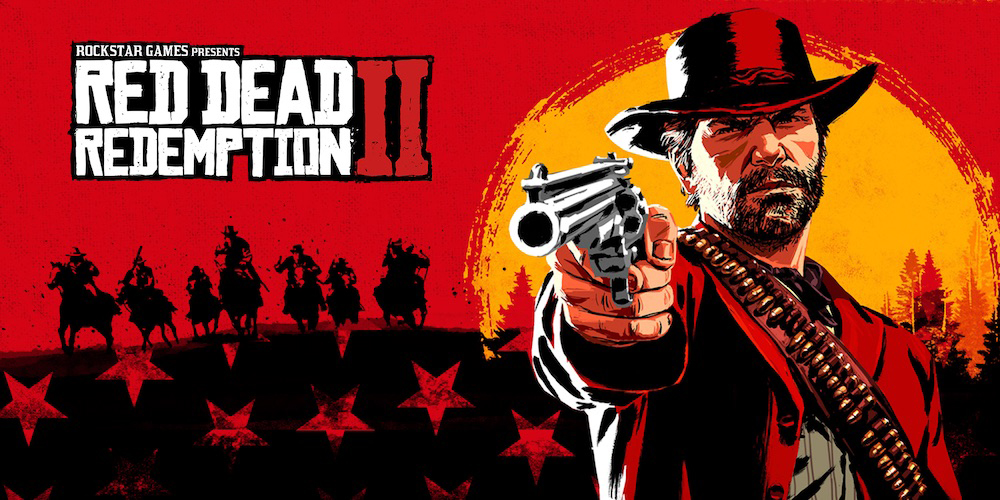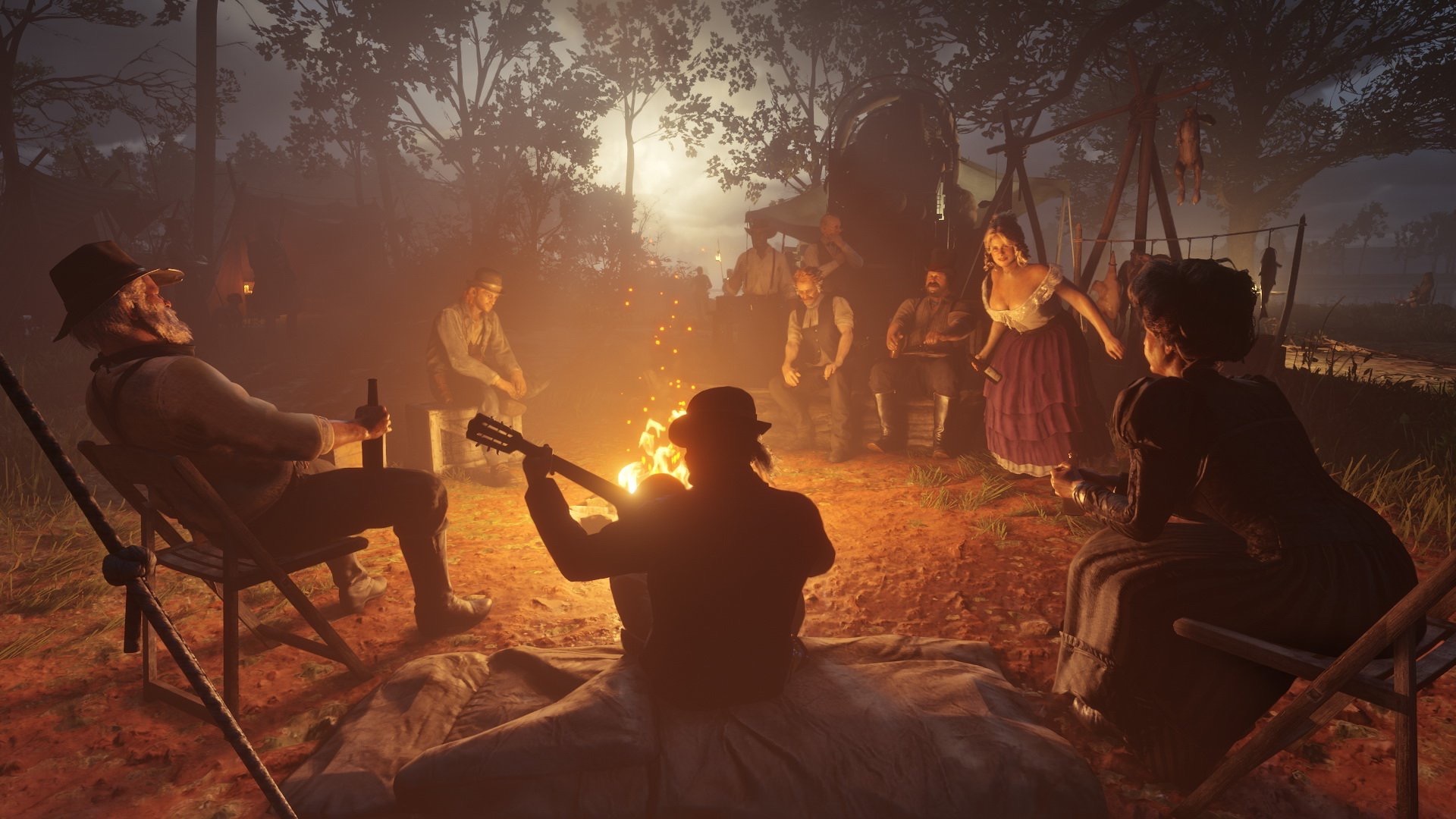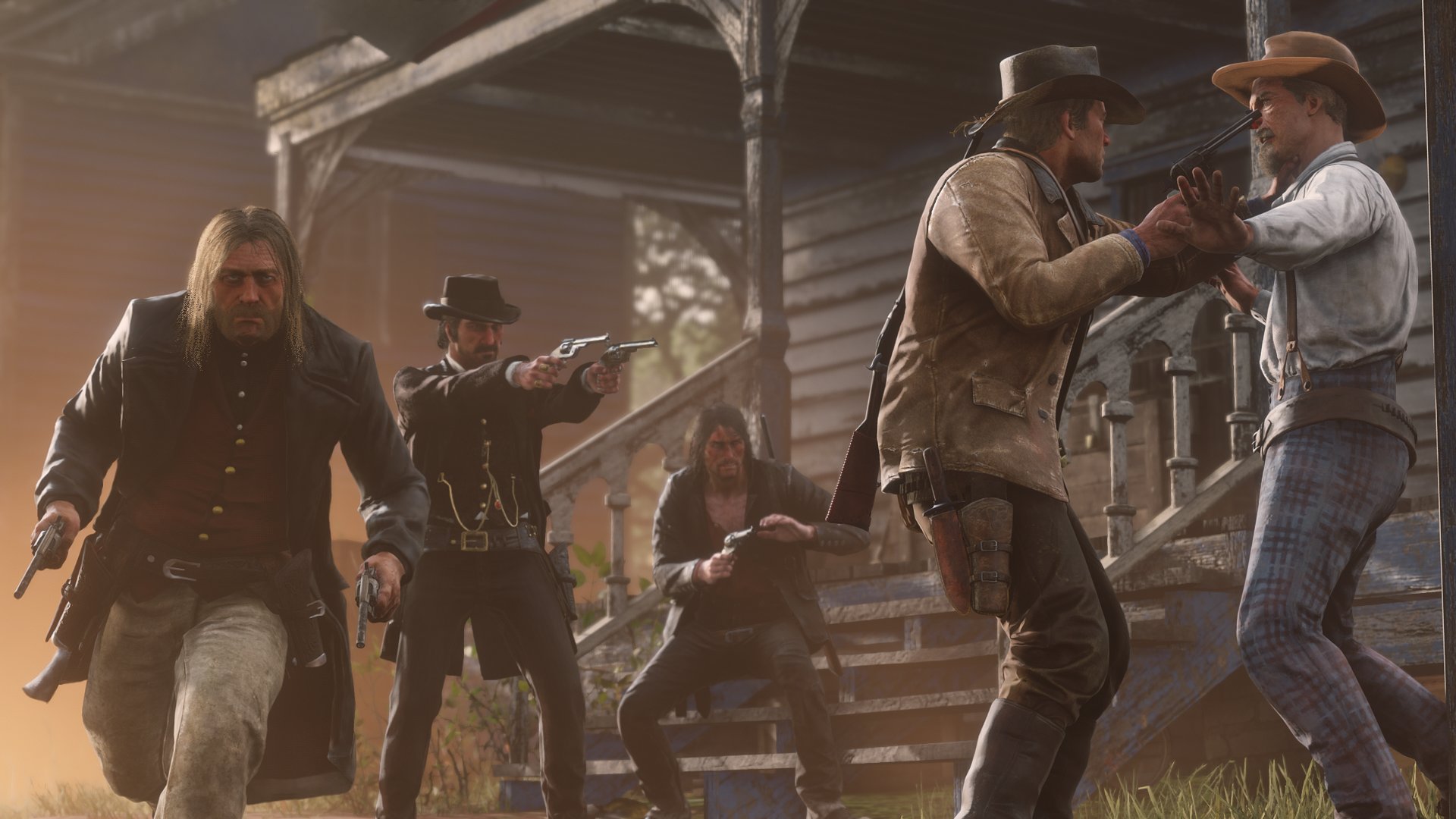
There’s a poignant scene around the middle of Red Dead Redemption 2 where your gang is celebrating the end of a successful mission by drinking and singing around the campfire. It contains one of the most beautiful animations I’ve seen in modern gaming – a split-second glance between two characters followed by a smile and a head upon a shoulder. “We’ve done it.” It was an absolute delight to experience and is the perfect illustration of Red Dead 2 – an uncompromising, idiosyncratic, but ultimately confident and astounding work of art. Despite its unconventional and sometimes hostile gameplay choices, Red Dead Redemption 2 consistently amazed me with its cinematic storytelling and sheer immersion.
Developed over eight years by more than 2,000 members of Rockstar’s global studios (the credits are over half an hour long), Red Dead Redemption 2 opens in the Grizzlies, a snowy and mountainous region in the fictional state of New Hanover. You play as Arthur Morgan, a senior member of the Dutch van der Linde gang who is travelling east to flee law enforcement. The opening hours are strictly linear and function as an extended tutorial for the many systems in the game. Soon after, players are given full agency and are permitted to explore the open world. It’s the most hand-holding I’ve experienced in a Rockstar game and is immediately indicative of how Rockstar wants players to experience the game – to take it slow and experience the world in all its beauty and horror.

Make no mistake, Red Dead Redemption 2 is more of a simulation than a conventional video game. Upon taking control of Arthur, I immediately noticed how plodding and deliberate his movements were. Every action – from turning his head to vaulting over obstacles – felt laborious and plain slow. This is most apparent in the default movement speed in indoor and camp environments. It’s uncompromising, and it’s not for everyone. But it’s also the appropriate cadence for Arthur’s character, a weary and sometimes cynical soul who has been through much during his time with Dutch. There’s no way to change this default speed. Initially, it felt frustrating, but after a day or so, I got used to this speed, and after finishing the main storyline, I understood why the designers intended for it to be this way.
Nevertheless, I expect many players may be put off by some of the more the complex and player-hostile gameplay idiosyncrasies. For example, you’re supposed to eat and shower regularly to maintain acceptable levels of health and honour respectively. Hunting and cooking your meals can require you to hunt an animal, season it with the appropriate herbs and spices (if you’d like to), then cook it. Showering requires players to scrub individual limbs literally. These can come across as hostile design choices. But doing chores around a camp and showering are never usually fun, and the developers would argue that such mechanics are crucial to creating the required agency and building immersion.

On the other hand, some may argue that such mechanics are unnecessary and frustrating. Shooting is also a mixed bag and exhibits the signature “stickiness” often associated with Rockstar games. This aim-assist can be turned off or toned down, only marginally improving the shooting experience.
Dutch’s gang is a large part of what gives Red Dead 2 a layer of humanity not often seen in games. These are outlaws and thugs – utterly flawed human beings – but they are your family. Through the course of the roughly 60-hour long story, you’ll journey with various gang members through a wide variety of story missions – from police escapes to full-blown heists and everything in between. The story is arguably the soberest and grounded in a Rockstar game. We uncover the struggles of being a mixed-race Native American/African American in 19th century America. We learn about how society treated the vocal minority of strong-willed women who were willing to take a stand against inequality. Tonally, though, I think Rockstar was not as brave or bold as they could’ve been – they played it unusually safe when delving into potentially sensitive subject matters. I understand why, but felt it marked a difference from the Rockstar which developed GTA V. Many details can be easily lost to players who race through the game. For example, you can talk to virtually any NPC by holding a left trigger button and choosing to either greet or antagonise them. Most of these interactions are 2-3 levels deep; however, some can trigger entire story missions. The only way to uncover these missions is to continue to converse and not assume all conversations have the same depth.

The performance capture is at the top of its class, and this extends to non-core NPCs whom you come across in the various towns. I played most of the game in third-person, but there were many scenes where the facial animations were so nuanced and subtle that I went into the first-person perspective so that I could appreciate the performances. The writing is also uniformly excellent and further cements Rockstar at the apex of cinematic storytelling.
Red Dead Redemption 2 is the first game where I have felt that a world was created. Very often, developers build open stages where players can roam freely and complete objectives at their will. When playing Red Dead 2, however, I kept remarking that Rockstar had genuinely created a world with various physical, societal and gameplay systems seamlessly interacting to simulate a Western world. It’s a difficult thing to describe and is something players should experience firsthand. Presentation-wise, I was continually amazed by how the game looked and performed on a base PS4. The level of detail is quite simply jaw-dropping and is often photorealistic. It’s probably also one of the best-performing Rockstar open world games at launch. In my time with the PS4 version, the game maintained a relatively stable framerate, with slowdowns only in the more populated towns. Riding in the open world is a real treat. I also really enjoyed the dynamic music engine employed by the game, which swells when ominous events are about to occur – for example, when bounty hunters are approaching your position. Without spoiling anything, the game also features surprising new songs from pre-eminent musicians at crucial moments in the game, making them unforgettable.

Red Dead Redemption 2 is undoubtedly a technical masterpiece and a new high watermark for cinematic storytelling. Whether players will enjoy playing Red Dead 2, however, will depend on how accommodating they are to Rockstar’s strong design choices. These choices prioritise immersion and realism over pure fun and will be off-putting to some. But perhaps we need to consider that maybe fun wasn’t the goal here; these mechanics were crafted to pull players into the world. After more than 70 hours with Red Dead 2, I had embodied and become Arthur. His choices were mine. Viewed from that lens, Rockstar has succeeded in giving players an unprecedented level of agency. Despite some gameplay quirks, I would wholeheartedly recommend Red Dead Redemption 2 as a must-play to all fans of video games. After all, isn’t escapism the very reason we play video games?











